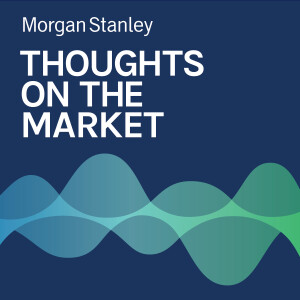
Sarah Wolfe: Are Consumers Going to Pull Back on Spending?
 2022-12-15
2022-12-15
While the consumer has been a pillar of strength this year, continued high inflation, household debt and slowing payroll growth could pose challenges to consumer spending.
----- Transcript -----
Welcome to Thoughts on the Market. I'm Sarah Wolfe from Morgan Stanley's U.S. Economics Team. Along with my colleagues, bringing you a variety of perspectives, today I will give you a year end 2022 update on the U.S. consumer with a bit of our outlook for 2023. It's Thursday, December 15th, at 10 a.m. in New York.
So it's very clear the consumer has been a pillar of strength this year amid a very tough macro environment, but as rates keep rising and the labor market slows, consumers will likely need to find ways to cut costs. We are already seeing some weakness in subprime consumers and trade down among middle and higher income households.
While the wallet shift away from goods and towards services is definitely playing out, we continue to see relatively more strength than expected from consumers across both categories. This is because households have lowered their savings rates significantly as they draw down excess savings. We do not expect a material drawdown in excess savings, however, into next year as savings dwindle. We are already seeing it this morning in the November retail sales data, where spending slowed down fairly dramatically across most goods categories. We're talking about home furnishing, electronics and appliances, sporting goods, motor vehicles. On the other hand, the one category of retail sales that reflects the services side of the economy, dining out, was very strong in the retail sales report and has continued to be very strong.
Looking at the trends that will force consumers to spend less, rising interest rates are lifting the direct costs of new borrowing and slowly feeding through into higher overall debt service costs. For example, new car loan rates are at their highest level since 2010, mortgage rates are at 20 year highs, they've come off a little bit, and commercial bank interest rates on credit card plans are at 30 year highs. It takes time for new debt issued at higher rates to lift household debt service costs, especially as over 90% of outstanding household debt is locked in at a fixed rate. But it's happening.
Looking at the data by household income shows more stress from higher rates among subprime borrowers. Credit card delinquencies are modestly below pre-COVID levels, but are accelerating at the fastest pace since the financial crisis. In the auto space, delinquencies across subprime auto ABS surpassed 2019 levels earlier this year and have stabilized at relatively high rates over the last six months.
Lower income households are also most affected by the combination of higher interest rates and higher inflation. They rely more heavily on higher interest rate loan products and variable rate credit card lines. Consider this, the bottom 20% income quintile spend 94% of their disposable income on essential items, including food, energy and shelter. This compares to only 20% of disposable income for the top 20% income quintile. As such, higher inflation on essential items weighs more heavily on lower income households. Higher inflation is also pushing lower income households to buy fewer full price items and wait for promotions. They are also choosing smaller items, value packs, or less expensive brands.
While price inflation has turned a corner, it's not enough to ease the pressure on consumers from elevated price levels, rising rates and additionally a decelerating labor market. We expect labor income growth to slow next year alongside a weakening labor market, troughing in mid 2023, in line with sharply slower payroll growth and softer wage gains. Wage pressures are coming off in industries that saw the largest wage gains over the past year due to labor shortages, including leisure and hospitality and wholesale trade. But for the moment, with jobs still growing, consumer spending remains positive as well. Together, our base case for real spending is a weak 1% year over year growth in 2023, down from 2.6% this year. In the end, the extent that consumers pull back spending will hinge on how the labor market fares.
Thanks for listening. If you enjoy Thoughts on the Market, please leave us a review on Apple Podcasts and share the podcast with a friend or colleague today.
More Episodes
 2024-02-23
2024-02-23
 2024-02-21
2024-02-21
 2024-02-16
2024-02-16
 2024-02-15
2024-02-15
 2024-02-14
2024-02-14
 2024-02-09
2024-02-09
 2024-02-08
2024-02-08
 2024-02-05
2024-02-05
 2024-02-02
2024-02-02
 2024-02-01
2024-02-01
 2024-01-30
2024-01-30
 2024-01-30
2024-01-30
Create your
podcast in
minutes
- Full-featured podcast site
- Unlimited storage and bandwidth
- Comprehensive podcast stats
- Distribute to Apple Podcasts, Spotify, and more
- Make money with your podcast
It is Free
- Privacy Policy
- Cookie Policy
- Terms of Use
- Consent Preferences
- Copyright © 2015-2024 Podbean.com




